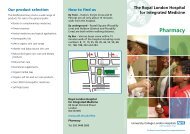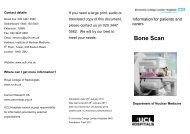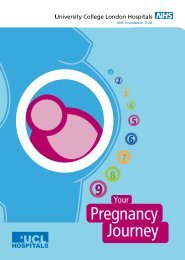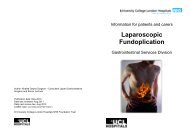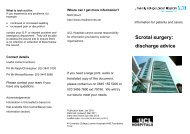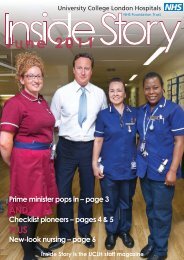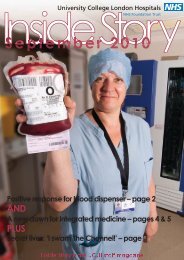Hip Joint Resurfacing - University College London Hospitals
Hip Joint Resurfacing - University College London Hospitals
Hip Joint Resurfacing - University College London Hospitals
Create successful ePaper yourself
Turn your PDF publications into a flip-book with our unique Google optimized e-Paper software.
Main switchboard: 0845 155 5000<br />
020 3456 7890=<br />
<strong>Hip</strong> <strong>Joint</strong> <strong>Resurfacing</strong><br />
and your recovery programme<br />
=<br />
A guide for patients and carers<br />
=<br />
=<br />
Publication date: June 2013<br />
Date next review due: June 2015<br />
Leaflet code: UCLH/S&C/SUR/ORTHO/HJR/1<br />
© <strong>University</strong> <strong>College</strong> <strong>London</strong> <strong>Hospitals</strong> NHS Foundation Trust<br />
=<br />
UCLH Trauma & Orthopaedic Team<br />
Please bring this booklet with you when attending your<br />
pre-assessment appointment and when you come in<br />
for surgery.<br />
=<br />
=<br />
QM=
If you would like this document in another language or<br />
format, or require the services of an interpreter, please<br />
contact us on 0845 155 5000 Ext. 73618. We will do our<br />
best to meet your needs. =<br />
Contents page<br />
Your hip joint resurfacing recovery plan 3<br />
Introduction 6<br />
The hip joint 6<br />
How can hip joint resurfacing surgery help? 6<br />
How long will your hip joint replacement last? 8<br />
What are the risks of surgery? 9<br />
What will happen if you choose not to have surgery? 12<br />
What are the alternatives to surgery? 12<br />
Asking for your consent 13<br />
Research 13<br />
What happens before you come into hospital? 13<br />
Plan before you come in to hospital 14<br />
What happens on the day of your operation? 18<br />
What should you expect straight after your operation? 19<br />
Getting up after your operation and preparing to go 20<br />
home<br />
On the day you go home 27<br />
Your recovery and frequently asked questions 28<br />
Where you can get more information 32<br />
Contact details 33<br />
Your exercises 34<br />
O=<br />
PV=
Your <strong>Hip</strong> <strong>Joint</strong> <strong>Resurfacing</strong> Recovery Plan<br />
GP referral<br />
• Your GP refers you to the Orthopaedic Consultant to<br />
discuss joint replacement surgery.<br />
• Your GP will request any tests needed to ensure you are<br />
fit for surgery.<br />
Making the decision to have surgery<br />
• The Consultant and their team will explain to you what is<br />
involved in hip joint resurfacing surgery, including benefits<br />
and risks.<br />
• The expected length of stay for hip joint resurfacing surgery<br />
is 2 – 4 nights.<br />
• You will make an informed decision to have the operation.<br />
• The admissions co-ordinator will contact you with a<br />
pre-assessment date, an admission date and your first<br />
follow up appointment in your Consultant’s clinic after<br />
your discharge from hospital.<br />
Pre – assessment clinic<br />
• This normally takes place 4 weeks before your operation.<br />
• You should allow 3-4 hours for the whole process.<br />
• You will attend an education session on how to prepare for<br />
joint replacement surgery.<br />
• In this session you will meet the therapists to discuss your<br />
individual needs to make your recovery faster and easier.<br />
• Post operative hip precautions will be explained to you.<br />
• You will be asked questions regarding your medical health<br />
by the nursing staff.<br />
• You may have an x-ray and blood tests.<br />
• When you come to pre-assessment please bring:<br />
√ Any questionnaires you was sent completed<br />
√ Any forms you was sent completed<br />
√ Your medication list<br />
√ Allergy list<br />
PU= P=
The day of your surgery<br />
• You will be admitted to hospital on the day of your surgery.<br />
• Bring all your medication with you.<br />
• You will be asked to report to the surgical reception.<br />
• You will meet your surgeon’s team and you will be asked to<br />
give your consent for surgery.<br />
• You will meet your anaesthetist and you will be assessed to<br />
decide what anaesthetic will be best for you.<br />
• You will meet a nurse who will complete the final health<br />
checks.<br />
• You will change into your hospital gown and your personal<br />
belongings will be securely locked away.<br />
Your surgery<br />
• You will be escorted to theatre and the anaesthetic room.<br />
• You will have your anaesthetic.<br />
• You will have your surgery.<br />
• You will wake up in the recovery area.<br />
• After a short stay in recovery you will be taken to your ward.<br />
The evening after your surgery<br />
• You can eat and drink normally when you are on the ward.<br />
• You will have medication to prevent blood clots forming and<br />
to manage pain.<br />
• You will wear compression stockings to help circulation.<br />
• If you are comfortable and able to, you can sit in a chair<br />
and walk a short distance with staff assistance.<br />
• You should start your leg exercises.<br />
Day one after your surgery<br />
• You should expect some pain after surgery, but you should<br />
be made comfortable with pain relief.<br />
• You should get dressed in your own clothes.<br />
• You will walk around the ward with walking aids.<br />
• You will practise your exercises 3 to 4 times during the day.<br />
• You will meet the therapists to discuss your discharge plan<br />
and how you will manage your daily tasks at home.<br />
Q=<br />
=<br />
Heel raises<br />
Stand holding onto a steady<br />
surface for support. Push up on to<br />
your toes, for 3-5 seconds. Then<br />
bring your heels back to the floor.<br />
Mini Squats<br />
Stand holding on to a steady<br />
surface for support. Slowly bend<br />
your knees, keeping your heels in<br />
contact with the floor. Return to<br />
the upright position.<br />
Quadriceps stretch<br />
Stand holding on to a steady<br />
surface for support. Slowly bend<br />
the knee of your operated leg,<br />
bringing your foot towards your<br />
bottom. Keep your knee pointing<br />
down to the floor, and do not lean<br />
forwards during this exercise.<br />
Slowly straighten your knee.<br />
PT=
<strong>Hip</strong> abduction<br />
Stand holding on to a steady<br />
surface. Raise your operated leg<br />
to the side; keep your toes<br />
pointing forward.<br />
<strong>Hip</strong> extension<br />
Stand holding on to a steady<br />
surface. Take your operated leg<br />
out behind you, keeping your<br />
knee straight. Do not lean<br />
forwards with your upper body.<br />
Standing hip flexion<br />
Stand holding on to a steady<br />
surface. Raise the knee of the<br />
operated leg in front of you (no<br />
more than 90 degrees). Keep<br />
your hip, knee and foot in line with<br />
each other as you do this<br />
exercise.<br />
Day two after your surgery<br />
• Any drips or drains after surgery will be removed either<br />
on day one or day two.<br />
• You will have your post-operative x-ray.<br />
• You will progress your walking and exercise programme.<br />
• You will practise activities to prepare for discharge –<br />
including washing, dressing and using stairs if needed.<br />
Day three/four after your surgery and discharge<br />
• When you are safe and confident with your activities and<br />
walking, you can go home.<br />
• Your medication prescription will be prepared.<br />
• Your post-discharge physiotherapy appointment will be<br />
arranged.<br />
• Your consultant appointment will be booked.<br />
• You will be given the contact details for the orthopaedic<br />
team.<br />
• On your day of discharge, family or friends can pick you up<br />
ideally before 11am.<br />
When you are home<br />
• If you have stitches or clips in your wound, we will inform<br />
your GP practice.<br />
• You will have physiotherapy 3 to 4 weeks after your surgery<br />
date. This can be at UCLH or at your local services.<br />
• You will have a consultant review 6 to 8 weeks after your<br />
surgery.<br />
• You will wear compression stockings for 4 weeks from<br />
the date of your surgery.<br />
• You will continue with your hip exercise programme for<br />
at least 12 weeks from the date of your surgery.<br />
PS=<br />
R=
Introduction<br />
If you are thinking about having a hip joint resurfacing or you<br />
have decided to go ahead with the operation, it is important that<br />
you understand every stage of the surgical process. This booklet<br />
explains what you should expect and how you can prepare for<br />
the surgery. Planning for your operation at each stage of the<br />
process will make your recovery much easier.<br />
At UCLH, patients are admitted on the day of their surgery, and<br />
will stay in hospital for an average of two to four nights.<br />
The information in this booklet is based on our practice at UCLH.<br />
It may be slightly different at other centres. The orthopaedic team<br />
will explain any differences to you and try to answer any<br />
questions you have.<br />
The hip joint<br />
The hip joint is at the top of your leg and is often described as a<br />
‘ball-and-socket’ joint. The ball is at the top of the thigh bone<br />
(femur), and fits into the hip socket (acetabulum). In osteoarthritis,<br />
the hip joint space can reduce and small, bony outgrowths called<br />
‘osteophytes’ can form.<br />
How can hip joint resurfacing surgery help?<br />
By replacing your arthritic hip joint with an artificial one, surgeons<br />
aim to:<br />
<strong>Hip</strong> abduction<br />
Lying on your bed, use your hip<br />
muscles to slide your operated leg<br />
out, away from your body, and<br />
then in again to the starting<br />
position.<br />
<strong>Hip</strong> flexion (bending)<br />
Lying on your back, keep your<br />
foot on the bed and slide it<br />
towards you to bend your knee,<br />
on the operated leg.<br />
Knee extension<br />
Sit on a chair: straighten your<br />
knee and tighten your thigh<br />
muscles. Hold for five seconds<br />
and slowly relax knee down again.<br />
• Reduce pain in your hip joint<br />
• Help you move more easily<br />
• Improve your quality of life<br />
The surgery replaces the surface on the head of the femur and<br />
re-lines the socket with a metal implant.<br />
S=<br />
PR=
Your exercises<br />
=<br />
Ankle Pumps<br />
In a lying or sitting position, slowly<br />
move your foot up and down. Try<br />
to avoid rubbing your heel on the<br />
surface of the bed. You can start<br />
this exercise straight after<br />
surgery.<br />
Static quads<br />
Push your knee down into the<br />
bed, tightening the muscle at the<br />
front of your thigh. Hold for 5-10<br />
seconds and then relax.<br />
Normal hip joint<br />
=<br />
=<br />
Static gluts<br />
Slowly squeeze your bottom<br />
muscles, hold for 5 - 10 seconds<br />
and relax.<br />
Inner range quads<br />
Place a rolled up towel under your<br />
knee. Keeping your knee on the<br />
towel, lift your foot off the bed.<br />
Try to get your knee completely<br />
straight, and then relax.<br />
<strong>Hip</strong> joint with osteoarthritis<br />
PQ=<br />
T=
Your surgeon has advised that you are more suitable for hip<br />
resurfacing rather than the conventional total hip replacement.<br />
Less bone is removed from the head of the femur (thigh bone)<br />
during hip resurfacing, so it is often possible to be more active<br />
than after a total hip replacement.<br />
Contact details<br />
On discharge you will be given the ward contact details for the<br />
nursing team and instructions which numbers to call if you have<br />
any questions regarding your post-operative recovery.<br />
To enquire about your district nurse visit contact your general<br />
practitioners practice.<br />
To enquire about your consultant follow up appointment<br />
please call the UCLH contact centre on 020 3447 9393.<br />
To enquire or make a physiotherapy outpatient appointment<br />
please call the UCLH contact centre on 020 3447 9393.<br />
To contact the UCLH Therapy & Rehabilitation (physiotherapists<br />
and occupational therapists) team regarding therapy questions<br />
other than outpatient appointments call:<br />
The UCLH switch board on 0845 155 5000 and extension 73618<br />
or Email: ortho-rheumtherapies@uclh.nhs.uk<br />
Both telephone messages and email in therapies are checked<br />
daily Monday to Friday.<br />
<strong>Hip</strong> <strong>Joint</strong> <strong>Resurfacing</strong><br />
Website: www.uclh.nhs.uk<br />
How long will your hip joint replacement last?<br />
<strong>Hip</strong> resurfacing is a newer operation and there are not many long<br />
term studies. A total hip replacement should work well for many<br />
years. In research studies, nine out of ten people find that their<br />
hip joint replacement lasts at least ten years. If your hip joint<br />
replacement eventually stops working properly through wear and<br />
tear, you can have an operation to replace it.<br />
U=<br />
PP=
Where can I get more information?<br />
Arthritis Research UK<br />
Copeman House<br />
St Mary’s Gate<br />
Chesterfield<br />
Derbyshire<br />
SA1 7TD<br />
United Kingdom<br />
National <strong>Joint</strong><br />
Registry<br />
NHS Choices<br />
The Royal <strong>College</strong> of<br />
Anesthetists<br />
“ Having surgery at<br />
UCLH” a patient<br />
education film<br />
PO=<br />
Telephone: 0300 790 0400<br />
Fax: 0300 790 0401<br />
Email:<br />
enquiries@arthritisresearchuk.org<br />
Web site:<br />
www.arthritisresearchuk.org<br />
Web site: www.njrcentre.org.uk<br />
Web site:<br />
http://www.nhs.uk/conditions/hipreplacement/pages/introduction.aspx<br />
Web site: http://www.rcoa.ac.uk<br />
Web site:<br />
http://www.uclh.org/PandV/Pages/<br />
HavingsurgeryatUCLH-vids.aspx<br />
UCL <strong>Hospitals</strong> cannot accept responsibility for information<br />
provided by other organisations.<br />
What are the risks of surgery?<br />
<strong>Hip</strong> joint resurfacing surgery generally has very good results and<br />
complications are rare. However, like any surgery, there are<br />
risks.<br />
• Anaesthetics can have side effects: You may feel sick<br />
after your anaesthetic. If so, we will give you medication to<br />
help this. You may have an allergic reaction to your<br />
anaesthetic, or develop breathing or heart problems. These<br />
problems are serious but rare. You will be monitored closely<br />
after surgery and we have the facilities and staff to address<br />
these problems, if they occur. If you do have allergies, you<br />
must let us know before your surgery.<br />
• Your hip joint could dislocate: (4% or 4 in 100 risk). The<br />
two parts of your hip joint replacement can slip out of place<br />
(dislocate). Dislocation is most likely to happen in the first six<br />
weeks after your surgery. This can happen because ligaments<br />
and muscles that normally keep your hip in position are<br />
disrupted during the operation. Your hip joint is at risk of<br />
dislocating until these structures become stronger. If your hip<br />
does dislocate, you may need an operation to put the parts<br />
back together again. You can reduce the risk of dislocation by<br />
strengthening your hip muscles before and after your<br />
operation, and by following the hip joint precautions after your<br />
operation.<br />
• A blood clot (thrombosis) in your leg: (3% or 3 in 100<br />
risk) or a blood clot in your lungs: (under 1% or 1 in 100<br />
risk). The latter is a serious complication and occurs when a<br />
blood clot in your leg travels through your bloodstream to your<br />
lungs. Wearing the elastic Thrombo-Embolitic Deterrent<br />
(TED) stockings that we provide after your surgery, taking<br />
medication which thins the blood, walking and keeping active<br />
as soon as you are able will all help the blood flow and<br />
reduce the risk of thrombosis. If you do develop a<br />
V=
thrombosis, we will treat it with further medication that thins<br />
your blood. In most people, the clot causes no trouble and<br />
goes away after treatment.<br />
• Damage to the nerves in your leg: (under 3% or 3 in 100<br />
risk). The nerves in your leg might be damaged during<br />
surgery. This can make your foot floppy and weak. Most<br />
people recover from this complication but this can take up to<br />
six months or more. If it happens to you, you may need<br />
further investigations to identify the problem. Patients can<br />
also experience some numbness around their wounds which<br />
may be permanent.<br />
• A heart attack, stroke or chest infection: (under 1% or 1<br />
in 100 risk). These things are more likely to happen if you<br />
already have heart disease or chest problems. We will identify<br />
any health risks you may have in your pre-operative medical<br />
assessment, before you have your operation.<br />
• Infection (under 1% or 1 in 100 risk). There is a risk of<br />
infection in the skin and tissue around your operated hip joint.<br />
Antibiotics directly before and after your surgery and keeping<br />
your wound clean will reduce the risk of infection.<br />
You will reduce the risk of infection if you and your visitors<br />
clean your hands on a regular basis, and avoid touching<br />
wounds, drips and drains. Whether in hospital or back at<br />
home, if you notice swelling, discharge or itching around your<br />
wound at any time, let your nurse, therapist or doctor know as<br />
soon as possible. It is important we treat any signs of<br />
infection early because a joint replacement that becomes<br />
infected might need another operation. If you do get an<br />
infection we will give you more antibiotics.<br />
feel back to your normal self. It is important that you give yourself<br />
time to recover after your operation. If you work, discuss with<br />
your consultant how much time you should take off work after<br />
your operation.<br />
What exercise can I do? Depending on your level of physical<br />
activity and exercise you might have to decrease or increase<br />
your activity after your operation. If you do not do any other<br />
exercise we advise you to continue with your hip exercises for a<br />
minimum of three months. If you have never exercised on a<br />
regular basis you might find the idea of exercising difficult. It is,<br />
however, very important you start and continue with the<br />
exercises.<br />
If you are very active and exercise often, discuss with your<br />
consultant and your physiotherapist what would be the advisable<br />
level of exercise for the first few weeks after your operation.<br />
Patients that have had hip resurfacing surgery tend to be more<br />
active than patients who have had a hip replacement. Please<br />
discuss with your consultant what sport you can do after your<br />
operation.<br />
How can I help my hip in the long term? Reducing or keeping<br />
your weight stable will help you keep mobile. Regular exercise is<br />
good for your joint replacement and for you. Walking, swimming<br />
and cycling are some activities that you can do in the long term.<br />
You can ask your consultant or your physiotherapist about what<br />
exercise you can do.<br />
• Broken bones: (under 1% or 1 in 100 risk). The bones in<br />
your hip can break during the surgery. Normally, these breaks<br />
can be fixed during the operation. If this happens, your<br />
NM=<br />
PN=
When can I do gardening? You can garden when you feel<br />
ready. If you start gardening soon after your operation, maintain<br />
the hip precautions. You might find it easier sitting on a chair.<br />
When can I kneel? We do not advise you to try kneeling for the<br />
first six weeks after your operation. Ask your therapist to show<br />
you how to kneel. You can learn how to kneel and still maintain<br />
the hip precautions.<br />
When can I stop worrying about the hip joint precautions?<br />
You are advised to follow the hip replacement precautions for at<br />
least six weeks following your operation. After the first six weeks<br />
we advise patients to discuss this with their consultant team in<br />
their post-operative follow up appointment.<br />
When will I see my consultant again? You will be given an<br />
appointment to see your consultant team six to seven weeks<br />
after your surgery date. You are more likely to see one of his<br />
team members rather than the consultant himself.<br />
When can I fly? Will I be stopped by airport security? We do<br />
not advise travelling on a long flight for the first weeks after your<br />
surgery. If you did travel we advise you to wear TED stockings.<br />
Most people with hip or knee replacement surgery will alert the<br />
airport security. Just inform the security staff that you have had<br />
joint replacement surgery.<br />
Since I have been home I feel more tired than usual. Is that<br />
normal? After your operation you might feel more tired than<br />
usual or that your hip joint is painful after you have been active. It<br />
is important that you take time to rest in between your active<br />
periods. You can discuss any questions you have with your<br />
therapist.<br />
How long will it take me to recover from my hip joint<br />
resurfacing? Your old hip pain and stiffness should go away<br />
very quickly but it does take time to get over having hip<br />
replacement surgery. It may be three to six months before you<br />
PM=<br />
surgeon may want you to restrict how much weight you put on<br />
your leg. This is to give it extra time to heal.<br />
• Damage to blood vessels: (under 0.5% or 5 in 1000 risk).<br />
This can happen during the operation if an instrument tears a<br />
hole in one of your big vessels around your hip joint.<br />
• Urine problems: (under 0.3 % or 3 in 1000 risk). If you<br />
cannot urinate (pass urine) after your operation, you may<br />
need a plastic tube (catheter) inserted to help you empty your<br />
bladder.<br />
• Dying from surgery (extremely rare). Deaths caused by<br />
anaesthesia are very rare. There are probably about five<br />
deaths for every million anaesthetics in the UK. Your<br />
anaesthetist will discuss the risk of the anaesthetic with you.<br />
The risk of death after a hip or knee replacement is minimal<br />
(0.1% or 1 in 1000 risk).<br />
• One leg slightly shorter than the other. We always try and<br />
make sure both legs are the same length. If you have a<br />
noticeable leg length difference, your doctors may refer you to<br />
the orthotics department to address this through adjustments<br />
to footwear.<br />
• Not all the pain disappears. This operation will only take<br />
away the pain that is caused by your arthritic hip joint. It will<br />
not help to relieve pain that is caused by problems elsewhere.<br />
Your surgeon will explain this to you in more detail when you<br />
are deciding about having surgery.<br />
• The hip joint replacement becomes loose. This can<br />
happen slowly over time, usually taking longer than 10 to 15<br />
years to become noticeable. If it happens, you may need<br />
another operation to replace the loose hip.<br />
NN=
What will happen if you choose not to have<br />
surgery?<br />
If your pain does not get any worse, and you can cope with it,<br />
you may not want to go through joint replacement surgery. A<br />
painful hip joint will not shorten your life. Some people find that<br />
the pain does not get worse over time and manage to live with it.<br />
If you have joint symptoms that are stopping you from enjoying<br />
life, research suggests that it is better to have surgery before you<br />
become too disabled.<br />
What are the alternatives to surgery?<br />
If you decide not to have hip joint replacement surgery there are<br />
strategies that could help you manage your daily difficulties.<br />
• Stay active: taking regular exercise may reduce your pain.<br />
Gentle exercise like walking, swimming, low impact<br />
exercises at home or a gym can be helpful.<br />
• Weight control: carrying extra weight puts a strain on your<br />
hips and knees. This is likely to make your pain worse. If<br />
you are overweight, losing weight may be all you need to do.<br />
• See a physiotherapist: physiotherapists can teach you how<br />
to exercise so you can strengthen your leg muscles and<br />
keep you mobile.<br />
• Get help with mobility: there are many devices to help you<br />
move around more easily and confidently, including walking<br />
sticks, other walking aids and shock-absorbing shoes.<br />
Pain relief with medication: Painkillers may help to control your<br />
pain. The most common painkillers are paracetamol and nonsteroidal<br />
anti-inflammatory drugs (NSAIDs). Speak to your GP<br />
and pharmacist before taking any medication as there are risks<br />
with taking any medication.<br />
NO=<br />
• Lean back. Then, keeping both knees together, lift both your<br />
legs into the car. Turn your hips at the same time as you bring<br />
your legs into the car. You can make swivelling easier by<br />
sitting on a plastic bag.<br />
• When travelling, keep your operated leg comfortable and the<br />
knee of the operated leg in front of you with your knees apart.<br />
Travelling by black taxis (cabs) might be difficult for the first few<br />
weeks due to the height of the step to get in and out of the<br />
vehicle. The therapist will discuss this with you and give you<br />
individual advice. If you use taxis regularly, you may want to use<br />
a local minicab company. You should be able to travel as a<br />
passenger in the front seat of an ordinary car quite easily.<br />
How long do I have to wear my TED stockings? We advise<br />
patients to wear the TED stockings for up to four weeks after<br />
their surgery date.<br />
When can I sleep on my side? You can sleep on your operated<br />
side once the wound has healed and you feel comfortable<br />
sleeping on that side. For the first six weeks we advise you to<br />
keep a pillow between your knees whether you are lying on your<br />
operated or non-operated side. Always take care when you are<br />
turning in bed.<br />
When can I have a bath? After your hip operation you have to<br />
maintain the hip joint precautions. You can have a bath six<br />
weeks after surgery. Your wound should be completely healed,<br />
and you should be able to get in and out of a bath safely. The<br />
therapist will discuss with you how to get in and out of the bath<br />
when you are in hospital.<br />
What about my personal relationship? If you do not have<br />
severe pain, it is safe to continue sexual activities as long as<br />
you:<br />
• avoid bending your hip or twisting your body. You may find it<br />
safer and less stressful to remain on your back.<br />
OV=
Your recovery and frequently asked questions<br />
Will I have pain after my operation? Pain caused by<br />
osteoarthritis will be helped by having hip joint resurfacing. You<br />
will experience some pain because you have had your operation<br />
and this continues for a short period of time after you have gone<br />
home. It is important that you take your prescribed pain relief<br />
medication on a regular basis once you return home. If you feel<br />
that you still have discomfort despite taking medication speak to<br />
your GP.<br />
What do I do if my leg swells up? We expect patients to have<br />
some leg swelling following surgery. Keeping mobile will help<br />
reduce the swelling. If the leg becomes hot and red please notify<br />
your GP immediately.<br />
When do my stitches or clips come out? If you have stitches<br />
or clips your wound will be assessed by the district nurse within<br />
two weeks after going home. We will notify your GP and the<br />
practice should arrange this.<br />
How do I get in and out of a car? The same hip joint<br />
restrictions you have in sitting will also apply to you sitting in a<br />
car.<br />
Before you travel by car as a passenger, follow these<br />
instructions:<br />
• Ensure the driver parks the car a few feet away from the<br />
kerb, so you can stand at the same level as the car.<br />
• Ask someone to put the front passenger seat back as far as<br />
possible to give you plenty of leg space. Recline the seat half<br />
way.<br />
• Facing the kerb, carefully lower yourself down, sliding your<br />
operated leg forwards. Do not hold onto the door. If you need<br />
support, hold onto the car frame or the seat behind you. Sit<br />
down carefully.<br />
OU=<br />
Asking for your consent<br />
If you decide to go ahead with the surgery, we must ask you to<br />
sign a consent form. This confirms that you agree to the<br />
procedure and understand what it involves. The surgeon will<br />
explain all the risks, benefits and alternatives before you sign the<br />
consent form. If you are unsure about any aspect of your<br />
proposed treatment, please speak to a senior member of staff<br />
again.<br />
Research<br />
We are asked by the Government to gather information about hip<br />
joint replacements so you will be asked to fill in questionnaires<br />
about yourself and your hip pain before and after your operation.<br />
We are also a large teaching hospital and carry out important<br />
research about joint replacements. You may be asked whether<br />
you would like to participate in this research but you do not have<br />
to take part.<br />
What happens before you come in to hospital?<br />
Following your decision to have hip joint resurfacing you will be<br />
offered a date for your pre-assessment clinic and the admission<br />
date for your surgery and information on these dates will be<br />
posted to you.<br />
The Pre-Assessment Clinic (PAC) is an outpatient clinic which<br />
you must attend before you are admitted to hospital for your<br />
operation. This clinic normally takes place four weeks before you<br />
come in to hospital. It can take up to two hours so please allow<br />
time. You will meet a nurse who will ask you questions about<br />
your general health and you might have medical checks, such as<br />
X-rays and blood tests. It is important that you bring your<br />
medication list with you and you inform us of any known<br />
allergies. Depending on your medical history you might meet an<br />
anaesthetist who will assess you regarding your anaesthetic.<br />
NP=
The joint recovery programme education session takes place<br />
on the same day as your PAC assessment and is a group<br />
session led by therapy and nursing staff who will be involved in<br />
your care. This session lasts approximately one hour. There will<br />
be a talk explaining what you should expect from your admission<br />
and advice on how you can prepare before and after your<br />
operation. During this session, you will also be assessed<br />
individually by the therapists, to identify the support you need to<br />
return safely home after your operation. Please feel free to bring<br />
a member of your family or a friend with you to the therapy<br />
session. Having someone with you can help you plan your time<br />
at home before and after your admission.<br />
It is important you attend both the PAC outpatient session and<br />
the therapy assessment. Not attending these sessions may<br />
delay your surgery.<br />
Plan before you come in to hospital<br />
Coming in to hospital<br />
Patients having a hip joint resurfacing on average stay in hospital<br />
2 to 4 nights. You will be admitted on the day of your operation.<br />
When you come in to hospital:<br />
• Please bring in all the medication you take.<br />
• Arrange how you will arrive on the day of your operation and<br />
who will pick you up when you leave hospital. We ask<br />
patients to be picked up by 11am on their discharge day. You<br />
will be able to travel as a passenger in a normal car and we<br />
will discuss with you how to get in and out of a car. Hospital<br />
transport is only provided to patients who for medical reasons<br />
are unable to use any other forms of transport. <strong>Joint</strong><br />
replacement surgery alone does not make you eligible for<br />
hospital transport.<br />
On the day you go home<br />
On the day that you go home you will be discharged from the<br />
ward by 11am. You may be asked to wait in the discharge<br />
lounge whilst you wait for your prescription.<br />
Car parking is very difficult around UCLH sites. Parking meters<br />
are located around the hospital site and you might not find free<br />
spaces. There is a drop off and pick up area at the back of the<br />
hospital. We do advise you to plan your travel back home before<br />
you come in to hospital.<br />
You will be discharged with a prescription of medication to help<br />
with your pain and medication that helps thin your blood (anticoagulants).<br />
The medication prescribed for pain is generally<br />
similar to what you have been taking before you came in to<br />
hospital.<br />
A discharge summary will be sent to your GP practice. If you<br />
have stitches or clips in your wound a district nurse will visit you<br />
within two weeks of your discharge to remove them.<br />
You will have a follow-up appointment with your consultant team<br />
six to eight weeks after your operation to check how things are<br />
going.<br />
You will have a physiotherapy referral to check your mobility and<br />
exercises three to four weeks after your operation date. This can<br />
be arranged either at <strong>University</strong> <strong>College</strong> <strong>London</strong> Hospital or your<br />
local physiotherapy department. Please let us know in the preassessment<br />
clinic where you prefer to attend physiotherapy.<br />
NQ=<br />
OT=
If you have a sturdy banister or rail, you should use this and your<br />
walking aid in the other hand.<br />
Washing and dressing<br />
Nursing and therapy staff will observe you dressing and washing<br />
on the ward. This is another way of identifying any specific needs<br />
you have.<br />
It is best to get dressed whilst sitting on a bed or a chair. Getting<br />
dressed when you are standing up can increase your risk of<br />
falling.<br />
You will have to consider your hip joint precautions for at least<br />
six weeks after surgery. You will not be able to have a bath for<br />
six weeks, whilst the wound is healing.<br />
Some suggestions for washing:<br />
• If you can access your shower safely, use a waterproof<br />
dressing for your wound whilst it is healing and maintain your<br />
hip precautions.<br />
• You can have a wash sitting at the sink, using a long handled<br />
sponge/loofah. It is best to wash your hair in this position too,<br />
making sure your knees are far apart whilst you lean forward.<br />
Alternatively with the assistance of another person, you could<br />
sit on a standard stool with your back to the sink and lean<br />
backwards to wash your hair.<br />
Depending on your needs, the therapists will advise you on<br />
dressing aids you require and their use.<br />
Toileting<br />
Follow the same instructions in sitting and standing. Make sure<br />
that the toilet paper is within easy reach so you don’t have to<br />
bend and/or twist forwards to reach it.<br />
• We recommend you bring your mobile phone, pens, paper<br />
and reading material. There is a pay phone system by each<br />
bed. Hospital gowns and soap is provided but you can bring<br />
your own nightwear and toiletries. Bring comfortable and<br />
easy fitting clothes and shoes. Shoes should be flat or with a<br />
low heel and non-slip. A bedside TV is available at a daily<br />
cost. Although there is a small locker next to your bed, we<br />
advise you do not to bring valuables to the hospital.<br />
Home: shopping, housework and environment<br />
Preparing your home environment and planning how you will<br />
manage daily tasks before you come in to hospital will help you<br />
regain your independence and confidence, once you are back at<br />
home. Before you come into hospital, you may find it helpful to:<br />
• Stock up on supplies. If you have access, you may find<br />
internet shopping useful. Plan how you will get your supplies<br />
for the first six weeks after your operation.<br />
• Re-arrange cupboards, drawers and the fridge so items you<br />
need are at waist height and easy to reach.<br />
• Make or buy frozen meals and vegetables to use when you<br />
first get home.<br />
• Plan where you will have your meals. It will not be easy to<br />
carry items when you are using elbow crutches.<br />
• Plan your housework. Do things like washing, cleaning and<br />
sorting out cupboards before you come in to hospital.<br />
After your hip joint resurfacing, you may go home with elbow<br />
crutches and your operated leg will be sore. This may affect your<br />
balance and your walking will change for the first few weeks after<br />
your operation.<br />
• Plan your home environment to reduce the risk of falling.<br />
OS=<br />
NR=
• Plan how you will carry things likes cups and drinks if you<br />
have elbow crutches.<br />
• Practise using your walking aids. Ask a member of staff to<br />
show you how to use elbow crutches when you attend your<br />
pre-operative therapy assessment. You can practice walking<br />
and going up and down stairs with the elbow crutches, if you<br />
will find this helpful.<br />
• Then bring your non-operated leg forwards, to be in line with<br />
your operated leg.<br />
=<br />
Your therapist will advise you when you can try to walk with one<br />
crutch or stick. You may even achieve this before you leave<br />
hospital.<br />
=<br />
• Think about what shoes you can wear when you are home.<br />
Choose flat or low heel shoes with a good grip.<br />
• Remove cables, wires, rugs or small carpets that you might<br />
trip on.<br />
• Do your rooms (such as the bathroom, bedroom, and kitchen)<br />
have easy access? Could you move furniture around to give<br />
yourself more space whilst you are using elbow crutches?<br />
• If you have pets that need looking after, dogs that need<br />
walking or get excited and jump up towards you, can a friend<br />
or a family member help look after them for the first few<br />
weeks after your operation?<br />
• Ensure your home is well lit.<br />
• Your seating surfaces (such as chairs, bed and toilet) must<br />
be set at a comfortable height for you to sit and stand with<br />
ease.<br />
• It will be useful to have a stool or high chair in your kitchen so<br />
you can sit if you need to.<br />
Ask friends or family who can assist you with some of these<br />
home tasks, before you come into hospital and try to have<br />
arrangements in place for when you get home.<br />
NS=<br />
Once you are safely walking with two crutches, we will teach you<br />
how to climb stairs. This usually happens on the second or third<br />
day of your stay (day 2 or day 3).<br />
Stairs<br />
Once you are safely walking with two crutches, we will teach you<br />
how to climb stairs. This usually happens on the second or third<br />
day of your stay.<br />
• When going upstairs:<br />
1. ‘non-operated leg (sometimes referred to as ‘good leg’)<br />
2. ‘operated leg (sometimes referred to as ‘bad leg’)<br />
3. crutches/sticks<br />
• When going downstairs:<br />
1. crutches/sticks<br />
2. operated leg (‘bad leg’)<br />
3. non-operated leg (‘good leg’)<br />
OR=
Sitting and standing<br />
Make sure your chair is at the appropriate height for you and<br />
your operated hip joint. Always consider the hip joint precautions<br />
when sitting and standing.<br />
To sit down, whilst your operated leg is uncomfortable, put your<br />
walking aids aside, use your hands to feel for the arms of the<br />
chair, and slide the operated leg forwards as you lower yourself<br />
onto the seat. Your arms and non-operated leg will take your<br />
weight as you sit down.<br />
To stand, use the same process in reverse. Take your weight on<br />
the non-operated leg and push up firmly with your hands,<br />
through the arms of the chair.<br />
Walking<br />
At first, you will use a frame or crutches when walking, and then<br />
you may progress to using sticks.<br />
When walking on flat ground, you should:<br />
• Place your walking aid in front of you.<br />
• Step forwards to the level of your walking aid with your<br />
operated leg.<br />
OQ=<br />
Furniture Measurement and a Social History forms will be<br />
posted to you. Please complete and bring these to your preassessment<br />
clinic. This will help the therapists assess your<br />
furniture heights and seating arrangements at home and plan<br />
your discharge with you. If you do need equipment, this will be<br />
discussed with the therapists.<br />
Outdoors and public transport<br />
Plan how you will manage your outdoor home environment.<br />
• Steps and uneven surfaces outside your house can be<br />
challenging. Plan how you will manage these before you<br />
come in to hospital. Discussing the environment set up with<br />
the therapists will help you manage more easily once you are<br />
home after your operation.<br />
• Unfamiliar surroundings with a lot of people, such as on<br />
public transport, might not be easy to cope with straight after<br />
your operation. Steps on to buses and trains can be higher<br />
than the average house step. We would advise that you think<br />
carefully before using public transport for the first few weeks<br />
after your operation, particularly busy times of travelling.<br />
Driving<br />
We normally advise patients not to drive for a minimum of six<br />
weeks and not until they have seen the consultant after their<br />
surgery. You should also inform the DVLA and your insurance<br />
company that you have had surgery.<br />
Work<br />
If you work, the general advice is a minimum of six weeks off<br />
work. You must discuss with your consultant how much time you<br />
should take off work after your operation. The time you have off<br />
will depend on the physical demands of your work.<br />
NT=
Improve your fitness and practice your exercises<br />
Stay active and improve your muscle strength and fitness by<br />
practising your hip exercises before and after your operation.<br />
This will help you recover more quickly after your hip joint<br />
resurfacing.<br />
What happens on the day of your operation?<br />
You will be admitted on the day of your surgery. On the day of<br />
surgery, if you have been asked to come into hospital at 7am,<br />
you should not eat after midnight but you may drink water until<br />
6am. Please have a large drink of water, ideally one or two cups,<br />
at 6am. You may also drink Powerade or Gatorade if you are not<br />
diabetic. These contain some sugar which may help you feel<br />
better than water alone. If you are diabetic you may only drink<br />
water.<br />
It is very important that you do not have any other type of drink<br />
as we may have to delay your surgery if you do. Fizzy drinks<br />
and anything containing milk are not safe. Do not drink<br />
anything after 6am unless instructed to do so by the hospital<br />
staff. If you have been asked to arrive at a different time, you<br />
may eat until 6 hours before your planned arrival time. You may<br />
drink water until 2 hours before your planned arrival time. Do not<br />
drink after this time unless instructed to do so.<br />
On the morning of your operation you will meet your consultant’s<br />
surgical team, the anaesthetist and a nurse. Once you have<br />
been assessed, you will be escorted to theatre. <strong>Hip</strong> joint<br />
resurfacing takes between one to two hours and you will also<br />
spend time in the recovery unit before you go to your ward. You<br />
will have either a general anaesthetic (a drug that sends you to<br />
‘sleep’), or an epidural (an injection into the spine), or both. If you<br />
only have an epidural, the lower part of your body will be numb<br />
and you will not feel anything. The theatre staff will put a screen<br />
up so you will not be able to see the surgery, but you may be<br />
able to hear what is going on.<br />
NU=<br />
To get in to bed:<br />
• First, sit down close to the head of the bed and far back<br />
enough so the back of your legs are supported by the bed.<br />
• Using your arms to help by pushing up through the bed,<br />
bring your legs onto the bed, without crossing or twisting<br />
them.<br />
Measuring a walking aid<br />
To measure a walking aid, stand tall and relax your arms by your<br />
side. The top of the walking aid handle should be level with your<br />
wrist skin crease. If you use a single walking aid, elbow crutch or<br />
walking stick, then you hold the walking aid on the opposite side<br />
to your operated leg.<br />
OP=
• help regain the movement of your hip joint<br />
Try to follow your exercises 3 times a day. Start with 5 repetitions<br />
of each exercise, increasing to 10 repetitions by the time you go<br />
home. Always exercise within comfort and pain limits.<br />
Exercise is very important: you need strong muscles to support<br />
your operated hip joint and help the healing process. You<br />
should continue these exercises after you go home.<br />
Getting in and out of bed<br />
Most patients get out of bed on the same day after their<br />
operation. Your operated leg is likely to feel heavy for the first<br />
few days after surgery and you will need to change the way you<br />
get in and out of bed. Staff on the ward will help you practice<br />
how to get in and out of bed after your operation. You must<br />
consider the hip joint precautions set out below during bed<br />
transfers.<br />
To get out of bed:<br />
• Consider which side of the bed you will use to get in and out<br />
of bed when you go home.<br />
• First, move your leg towards the edge of the bed, keeping<br />
your hips apart.<br />
• Bring both legs over to the edge of the bed, without twisting<br />
and sit up. Use your arms to push up.<br />
What should you expect straight after your<br />
operation?<br />
When you wake up, you will be lying on your back with a needle<br />
in your arm that is connected to a bag of fluids and/or medication<br />
(called a ‘drip’). You may also notice a plastic tube (a ‘drain’)<br />
coming out of the top of your leg, which stops fluid collecting<br />
under your scar. The drip and drain will usually be taken out after<br />
one day. We will give you elastic stockings (TED stockings) to<br />
help the circulation in your legs. Your scar will be on the side of<br />
your hip, closed with stitches, clips or surgical glue and it will be<br />
covered with a dressing.<br />
Most patients will be able to drink water soon after the operation<br />
and eat and drink normally once back on the ward.<br />
You will feel pain and stiffness in your operated hip joint. You<br />
should tell the nurses if you are in pain as too much pain can<br />
delay your recovery. The nurses will provide you with the right<br />
painkillers and can contact the doctors if there are any problems.<br />
There are several options to help control pain:<br />
• Medication may be given to you through a drip and you will<br />
be able to control your own pain relief by pressing a button.<br />
This is called PCA (patient controlled analgesia). You can<br />
press the button as often as you need to; a limit is set to stop<br />
you taking too much. Taking more painkillers than you need<br />
may make it harder for you to get out of bed.<br />
• There is a wide range of painkillers (analgesics), which are<br />
available from the hospital pharmacy. These drugs may<br />
cause side effects like vomiting or constipation. If you feel<br />
sick or constipated, please tell a nurse. Tablets or an<br />
injection can be given to stop you feeling sick, and laxatives<br />
can be given to prevent constipation.<br />
OO=<br />
NV=
Getting up after your operation and preparing to go<br />
home<br />
physiotherapist or occupational therapist about safe ways to<br />
do this.<br />
Most patients can get out of bed and walk, taking their full weight<br />
on their operated leg, as soon as they feel able after their hip<br />
replacement surgery. This can happen on the evening of your<br />
operation day.<br />
Once you are walking safely, able to perform your home exercise<br />
programme and can carry out day-to-day tasks like washing,<br />
dressing and climbing steps or stairs, you can go home. Most<br />
patients recover quickly and stay in hospital for two to four<br />
nights.<br />
Nursing and therapy staff will guide you through your postoperative<br />
rehabilitation programme and advise you how to<br />
manage your day-to-day activities when you return home.<br />
Remember to take care when doing these activities and follow<br />
the advice we give you.<br />
• Do not twist on the operated leg when standing or walking.<br />
Always pick your leg up to turn.<br />
During your stay, you will have an X-ray to check your hip joint<br />
replacement.<br />
How can you reduce the risk of dislocation?<br />
To minimise the risk of dislocating your hip joint replacement, we<br />
advise you to follow a few simple rules for at least six weeks after<br />
your surgery. Your consultant’s team will advise you on the<br />
number of weeks you should keep these rules:<br />
• You can bend forward with your knees wide apart. A<br />
therapist will show you how to do this. Do not bend over<br />
your operated hip with your knees together especially<br />
when sitting down or getting on and off your chair, your bed<br />
or the toilet, when putting on clothes or shoes or picking<br />
things up from the floor.<br />
• Do not cross your legs at the knee or ankle (even when<br />
sleeping). If you normally sleep on your side, talk to your<br />
OM=<br />
Exercising<br />
You can start your hip exercises on the evening of your<br />
operation day.<br />
You will find the exercises at the end of this booklet.<br />
The exercises will:<br />
• assist circulation<br />
• strengthen the muscles of your operated leg<br />
ON=



